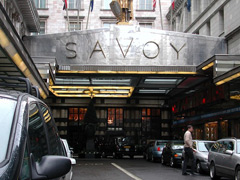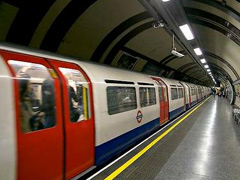


From Walter Sickert’s often gruesome depictions of Camden to Turner’s dramatic images of the Battle of Trafalgar, artists have turned to everyday life, the city’s history, and often some very random places to find their muse.
Soho
The Coach and Horses has long been a favourite with thesps and artists. It also has a reputation for debauchery thanks to former patrons George Melly, Francis Bacon and Jeffrey Bernard. The latter used his experiences at this Soho pub, most of which involved extreme inebriation, as fodder for his weekly Low Life column for The Spectator.
Denmark Street has been associated with musicians since the 1920s. Home to numerous rehearsal and recording studios, The Rolling Stones, The Beatles and Jimi Hendrix recorded here. The Kinks song Denmark Street summed up their experience with “You go to a publisher and play him your song/He says ’I hate your music and you hair is too long/But I’ll sign you up because I’d hate to be wrong’”. Denmark Street is also where Elton John composed his first hit, Your Song, and where the Sex Pistols made their very first demos. Malcolm McLaren’s project lived in a flat above the studio till they could no longer make the rent. The musicians frequented the Giaconda Café, and it was not uncommon to spot David Bowie and Joe Strummer glugging tea here. The cafe still stands today, renamed the Giaconda Dining Rooms.
\n\nLuxury hotels
The Savoy was London’s first luxury hotel. Oscar Wilde stayed here with his lover Lord Alfred, leading to the hotel’s name popping up frequently in court as the writer was tried for his deviant behaviour. Both Claude Monet and Whistler stayed here, and painted the view of Waterloo Bridge from their rooms. Bob Dylan filmed the video for Subterranean Homesick Blues next to the hotel in 1965, and it’s also made an appearance in films as disparate as Notting Hill and The French Lieutenant’s Woman.
Why hotel rooms seem to inspire the urge to trash them is anyone’s guess. While staying at the plush Sanderson the late Amy Winehouse got into a particularly vicious fight with her husband at the time, Blake Fielder-Civil, causing thousands of pounds of damage to the room. A member of staff was later quoted as saying that an outside cleaning firm was needed to remove the blood from the walls. If those walls could talk…
Museums
Given their educational nature, it’s somewhat curious that museums don’t crop up more often at the top of artists’ inspirational lists. Who wouldn’t find themselves moved to create after a walk through the ,a href="http://www.allinlondon.co.uk/the-tate-modern.php">Tate Modern or the V&A? Fashion designer Paul Smith likes the eclectic nature of Sir John Soane’s Museum due to the sheer number of artefacts Soane collected on his travels; Smith is a keen collector himself.
Celebrity haunts
Many private members clubs were founded with the intention of fostering relationships between creative people, however more often than not they end up becoming little more than a symbol of social status. Just look at Shoreditch House, where you’re more likely to encounter City folk relaxing by the pool instead of bohemian local artists, or the starry Groucho Club, where it’s more usual for members to turn up and get trollied than discuss their latest masterpiece.
In the late 60s the Chelsea Drugstore on the King’s Road was a popular musicians’ haunt. The complex attained notoriety as the bars and record shops within stayed open for 16 hours a day, much to the chagrin of the locals. The Rolling Stones were known to hang out here, and mention the Drugstore in their 1969 hit You Can’t Always Get What You Want. A scene in Stanley Kubrick’s A Clockwork Orange was filmed here, with the Drugstore pretty much unchanged; it appears as a bar/club where the main protagonist tries his luck with several girls.
\n\nIn the neighbourhood
When it comes to filmmaking, it seems that romance is to be found in wealthier neighbourhoods, while for urban grit screenwriters look east. Just look at the East End gangster movies of the late 90s, and the smoochy Notting Hill. More recently Shane Meadows’ Somers Town attempted to realistically depict the area in the title, but the film lost some credibility due to being funded by Eurostar, shortly after Kings Cross St Pancras finished its gleaming renovation.
The London Underground has also inspired its fair share of feature films. The spooky Creep is shot almost entirely on the Underground, featuring a well-to-do woman who spends the night trapped between tube stations with a disfigured murderer.
Random places
Art in abandoned spaces and street art is highly fashionable. Banksy is by far the most famous of these guerrilla artists, using walls as his canvas. The East End has been a hotbed of graffiti art for years, however with the Olympics looming Hackney Council decided to clean it up. But there are other forms of art to be found in unlikely places, such as Pierre Vivant’s Traffic Light Tree on Westferry Road, which brings colour to an otherwise drab bit of highway. According to the artist he took inspiration from the commerce of the local area, as the changing lights symbolise the pace of the City’s financial activities.
Polly Morgan, an artist who specialises in taxidermy, finds simply leaving the house handy when she starts to run low on ideas. Specifically, she heads to Battersea Dogs Home. (It must be noted that her taxidermied animals are either roadkill or donations from the owners).
In terms of finding one’s muse, it seems there is no hard and fast rule, it can happen anywhere.


